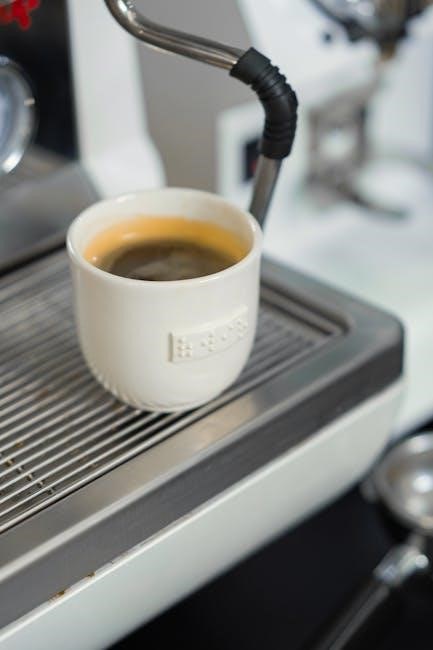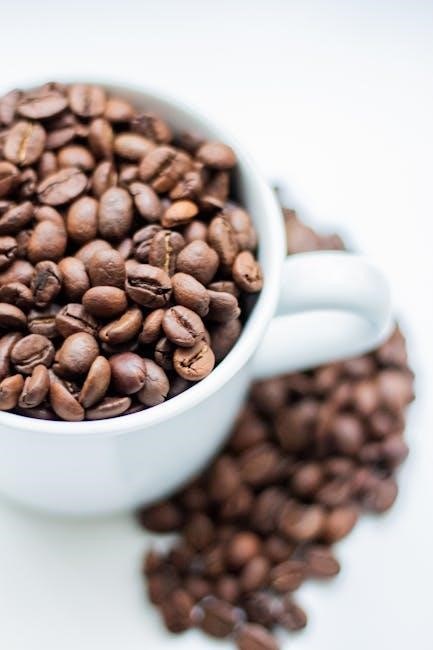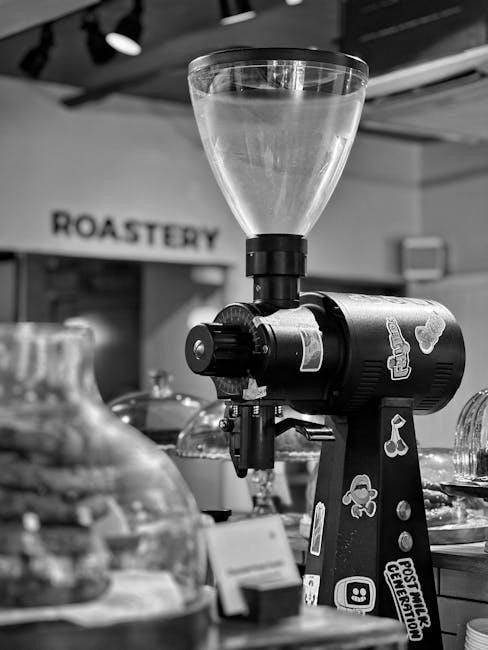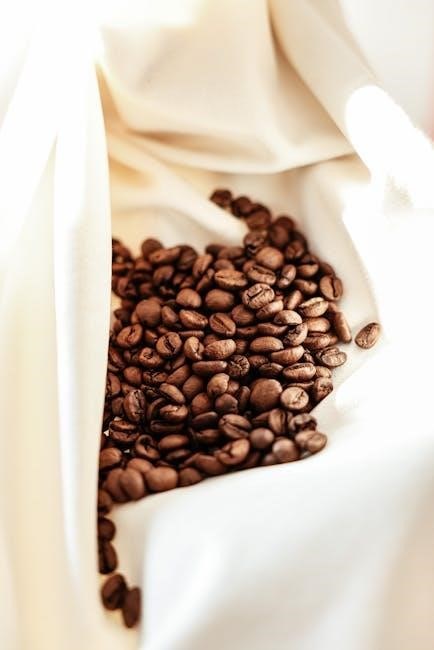A coffee grind size chart is an essential tool for coffee enthusiasts, providing guidance on optimal grind sizes for various brewing methods to ensure a perfect cup every time․
What is a Coffee Grind Size Chart?
A coffee grind size chart is a visual guide that helps coffee enthusiasts determine the ideal grind size for various brewing methods․ It provides a detailed comparison of grind sizes, often likening them to everyday items such as table salt, sand, or peppercorns, to ensure consistency․ The chart typically includes a range of grind sizes, from fine to coarse, and explains how each corresponds to different brewing techniques like espresso, pour-over, or French press․ Many charts are available as printable PDFs, making them easy to reference while brewing․ Some charts also offer tools to generate grind size settings for specific coffee grinders, ensuring precise adjustments․ By standardizing grind sizes, the chart helps users achieve the perfect extraction and flavor in their coffee, whether they’re using a manual grinder or an electric one․ It’s a must-have resource for both novice and experienced coffee brewers․
Why is a Coffee Grind Size Chart Important?
A coffee grind size chart is crucial for achieving consistent and flavorful coffee․ Proper grind size ensures optimal extraction, preventing bitterness or blandness․ It guides brewers in selecting the right grind for methods like espresso, pour-over, or French press, enhancing their brewing skills․ By comparing grind sizes to everyday items, the chart simplifies the process, making it accessible to all skill levels․ Regular use helps avoid common mistakes, such as incorrect grind settings, which can ruin a cup․ The chart also aids in calibrating grinders, ensuring precise adjustments․ Overall, it’s an essential tool for anyone seeking to elevate their coffee game and enjoy a perfectly balanced cup every time․

Importance of Grind Size
Coffee grind size significantly impacts flavor extraction, ensuring a balanced cup․ Proper grinding prevents under-extraction or over-extraction, making it vital for achieving the perfect brew every time․
How Grind Size Affects Flavor
The grind size of your coffee beans directly influences the flavor profile of your brew․ A finer grind allows for more surface area exposure, leading to faster extraction and a bolder, more intense flavor; Conversely, a coarser grind results in slower extraction, which can produce a lighter, more nuanced cup; If the grind is too fine, it can cause over-extraction, resulting in a bitter taste․ On the other hand, a grind that’s too coarse may lead to under-extraction, making the coffee taste weak or sour; Achieving the ideal grind size ensures a balanced extraction, bringing out the optimal flavors and aromas of the coffee․ Proper grind size is crucial for unlocking the full potential of your coffee beans and enjoying a perfectly brewed cup․
- Fine grind: Bold, intense flavor with potential for bitterness if over-extracted․
- Coarse grind: Lighter, nuanced flavor with risk of under-extraction if too large․
The Role of Extraction in Coffee Brewing
Extraction is the process by which flavors and oils are drawn from coffee grounds into water, forming the basis of your brewed coffee․ The grind size plays a critical role in determining the rate and efficiency of extraction․ A finer grind increases the surface area, leading to faster extraction, while a coarser grind slows it down․ Proper extraction is essential for achieving a balanced flavor, as under-extraction can result in a sour or weak taste, while over-extraction can make the coffee bitter․ The ideal extraction typically occurs when 18-22% of the coffee’s solids are dissolved․ Understanding how grind size influences extraction helps in tailoring the brewing process to suit different methods, ensuring a consistently delicious cup of coffee․ This balance is key to unlocking the full flavor potential of your coffee beans․
- Extraction rate: 18-22% solids for optimal flavor․
- Grind size adjusts the speed of extraction․
- Proper extraction prevents under or over-extraction issues․
Common Mistakes to Avoid
When using a coffee grind size chart, there are several common mistakes to avoid for optimal results․ One of the most frequent errors is using the wrong grind size for the brewing method, which can lead to under or over-extraction․ Another mistake is not calibrating the grinder regularly, causing inconsistent particle sizes․ Some people also fail to adjust the grind size based on the coarseness or fineness of their coffee beans, which can affect extraction rates․ Additionally, using a blade grinder instead of a burr grinder can generate uneven particles, impacting flavor․ Lastly, not measuring the coffee grounds accurately can throw off the balance, even with the right grind size․ Avoiding these mistakes ensures a more consistent and flavorful brewing experience․
- Incorrect grind size for the brewing method․
- Not calibrating the grinder regularly․
- Using a blade grinder instead of a burr grinder․
- Not adjusting for bean origin or roast level․
- Inconsistent measurement of coffee grounds․

Coffee Grind Size Chart
A coffee grind size chart is a detailed guide that outlines the ideal grind sizes for various brewing methods, ensuring optimal extraction and flavor in every cup of coffee․
Overview of the Chart
The coffee grind size chart provides a comprehensive visual guide, categorizing grind sizes from super fine to coarse․ It serves as a quick reference for coffee enthusiasts to match grind sizes with brewing methods․ The chart typically includes detailed descriptions, comparisons to everyday items, and specific measurements for consistency․ For instance, espresso requires a fine grind similar to table salt, while French press needs a coarse grind akin to peppercorns․ By standardizing grind sizes, the chart ensures proper extraction, balancing flavors and preventing bitterness․ It also offers printable versions, making it easy to use in home or professional settings․ This tool is indispensable for achieving the perfect cup, regardless of the brewing technique or grinder type․ Its simplicity and clarity make it accessible to both novices and experienced baristas, fostering a deeper understanding of coffee preparation․
Comparisons to Everyday Items
The chart simplifies understanding by comparing grind sizes to familiar items․ Fine grinds resemble flour or table salt, ideal for espresso, while medium grinds are like sand, perfect for pour-over․ Coarse grinds match peppercorns or sea salt, great for French press․ These comparisons help visualize the texture needed for each brewing method․ For example, a drip coffee grind is slightly coarser than sand but finer than kosher salt․ Such relatable references make it easier to adjust grinders accurately․ The chart also includes visual aids, like printable guides, to help users match their grinds to everyday objects․ This approach ensures consistency and improves brewing results․ By linking grind sizes to common items, the chart becomes a practical tool for coffee lovers of all skill levels, enhancing their ability to craft perfect cups consistently․
How to Read the Chart
The coffee grind size chart is designed to be user-friendly, with clear categories and comparisons․ It typically features columns listing grind sizes (fine, medium, coarse) alongside corresponding brewing methods and visual references․ To read it effectively, start by identifying your brewing method, such as espresso, pour-over, or French press, and locate the recommended grind size․ The chart often includes descriptions like “fine as table salt” or “coarse as peppercorns” to help visualize the texture․ Some charts also provide numerical measurements or settings for specific grinders․ For accuracy, use the chart in conjunction with a grinder calibration guide․ Printable versions are available for easy reference, ensuring consistency in your brewing process․ By matching your grinder settings to the chart, you can achieve the perfect grind for your favorite coffee drinks․

Brewing Methods and Grind Sizes
Different brewing techniques require specific grind sizes, from fine espresso grinds to coarse French press textures, each ensuring optimal extraction for a flavorful cup of coffee․
Drip Coffee
Drip coffee requires a medium-coarse grind size, often compared to kosher salt or slightly coarse sand, to ensure proper extraction․ This grind size allows water to flow evenly through the coffee grounds in an automatic drip brewer, preventing clogs and over-extraction․ A grind that’s too fine can lead to bitter flavors, while a grind that’s too coarse may result in a weak or under-extracted cup․ To achieve the perfect balance, it’s essential to use a burr grinder to maintain consistency in the grind size․ Adjustments may be needed based on the specific drip coffee maker and personal taste preferences․ For example, some machines might require a slightly finer grind to compensate for slower water flow rates․ Experimenting with the grind size can help optimize the flavor and aroma of your drip coffee, ensuring a delicious and satisfying brew every time․
French Press
French Press, also known as immersion brewing, requires a coarse grind size for optimal flavor․ The grind should resemble coarse sea salt or peppercorns, allowing the coffee grounds to steep evenly in the water․ A coarser grind prevents fine particles from passing through the press, which can result in a muddy or over-extracted cup․ Using a burr grinder is recommended to achieve consistent grind size, as blade grinders can create uneven particles․ The coarse grind ensures proper extraction during the 4-minute steeping time, leading to a rich, full-bodied coffee․ If the grind is too fine, it can clog the press and result in a bitter taste․ Conversely, a grind that’s too coarse may lead to under-extraction and a weak flavor․ Adjusting the grind size based on personal preference and the specific French Press used can help achieve the perfect balance of flavor and aroma․
Espresso
Espresso requires a super fine grind size, often compared to fine sand or brown sugar, to ensure proper extraction․ The grind must be even and consistent to prevent channeling, where water flows through the coffee unevenly, resulting in under-extracted or over-extracted shots․ A burr grinder is essential for achieving this precise grind size, as blade grinders can create inconsistent particles․ The ideal grind allows for a 25-30 second extraction time, producing a rich, creamy shot with a thick crema․ If the grind is too fine, it can cause the machine to struggle, leading to a bitter taste․ Conversely, a grind that’s too coarse may result in a weak or sour shot․ Adjusting the grind size based on the espresso machine and personal preference is crucial for achieving the perfect shot․ Proper tamping and distribution of the grounds in the portafilter are also essential for optimal flavor․
Pour-over
Pour-over brewing requires a medium-coarse grind size, similar to kosher salt or slightly coarser sand, to ensure optimal extraction․ This grind allows water to flow evenly through the coffee grounds, promoting a balanced extraction․ If the grind is too fine, it can clog the filter, leading to under-extracted, sour coffee․ Conversely, a grind that’s too coarse may result in a weak or under-flavored cup․ The ideal grind size enables a steady flow rate, typically taking 3 to 4 minutes for a standard pour-over․ Consistency is key, as uneven grind sizes can disrupt the extraction process․ Adjusting the grind size based on the specific pour-over method and coffee beans ensures the best flavor․ Using a burr grinder is recommended for precise control over the grind size, allowing for consistent results․ Experimenting with slight adjustments can help refine the flavor to suit personal preferences․
Chemex
The Chemex method requires a medium-coarse grind size, slightly coarser than kosher salt or sand, to ensure proper extraction and a clean, balanced flavor․ This grind size allows water to flow smoothly through the thick paper filter, preventing clogging and over-extraction․ A grind that’s too fine can lead to a bitter taste and slow brewing, while a grind that’s too coarse may result in a weak or under-extracted cup․ The ideal grind size enables a steady flow rate, typically taking 4 to 5 minutes for a standard Chemex brew․ Consistency is key, as uneven grind sizes can disrupt the extraction process․ Adjusting the grind size based on the specific coffee beans and roast level ensures the best flavor․ Using a burr grinder is recommended for precise control over the grind size, allowing for consistent results․ Experimenting with slight adjustments can help refine the flavor to suit personal preferences and achieve the perfect cup․
Cold Brew
Cold brew coffee typically requires a coarse grind size, similar to kosher salt or very coarse sand, to ensure proper extraction during the extended steeping process․ The grind size should be consistent to allow for even extraction, as the coffee grounds will steep in water for 12 to 24 hours․ A grind that’s too fine can lead to over-extraction and a bitter flavor, while a grind that’s too coarse may result in a weak or under-extracted brew․ The coarse grind size helps prevent the coffee from becoming overly concentrated and ensures a smooth, balanced flavor․ Using a burr grinder is recommended for achieving the desired consistency․ Adjusting the grind size slightly can help refine the flavor profile, making it essential to experiment and find the optimal size for your specific cold brew setup and coffee beans; This method highlights the importance of grind size in achieving the perfect cold brew․

How to Choose the Right Grind
Choosing the right grind involves matching your brewing method, grinder type, and desired flavor profile․ Adjust grind size based on extraction time and equipment for optimal results․
Factors Influencing Grind Size
Several factors influence the ideal grind size for your coffee․ The brewing method is the most critical, as different techniques require varying particle sizes for proper extraction․ Espresso demands a fine grind, while French press needs a coarse one․ Additionally, the type of grinder used can affect consistency, with burr grinders offering more precise control than blade grinders․ Water temperature and steeping time also play roles, as they influence extraction rates․ The coarseness or fineness of the grind must balance with these elements to achieve a balanced flavor․ Furthermore, personal taste preferences, such as bitterness or brightness, can guide adjustments․ Understanding these factors ensures a tailored approach to grinding, enhancing the overall coffee experience․
Step-by-Step Guide to Selecting Grind Size
To select the right grind size, start by identifying your brewing method, as each requires a specific particle size․ For example, espresso needs a fine grind, while French press requires a coarse one․ Next, refer to a grind size chart to determine the ideal setting for your method․ Adjust your grinder accordingly, using comparisons to everyday items like table salt or sand for reference․ Pay attention to the grinder’s settings, as some models offer numerical or incremental adjustments․ After grinding, assess the texture visually and tactilely․ If needed, refine the grind based on the flavor profile of your last brew—finer for stronger coffee or coarser for a lighter taste․ Finally, store any unused grounds properly to maintain freshness and consistency in future brews․

Tools for Grinding
Coffee grinders are essential tools for achieving precise grind sizes․ Blade and burr grinders are common types, with burr grinders offering more consistent results․ Calibration options and comparisons to everyday items like table salt help ensure accuracy․
Types of Coffee Grinders
Coffee grinders come in various types, each offering unique features and benefits․ Blade grinders are the most common and affordable, using spinning blades to chop coffee beans․ However, they can generate heat, which may affect flavor․ Burr grinders, on the other hand, crush beans between abrasive surfaces, ensuring consistent grind sizes without heat buildup․ Manual burr grinders are cost-effective and offer precise control, while electric burr grinders provide convenience and speed for daily use․ Additionally, some grinders combine multiple functions, such as grinding and brewing in one unit․ The choice of grinder depends on personal preference, budget, and the desired level of precision․ Burr grinders are highly recommended for achieving optimal grind sizes for various brewing methods․
How to Calibrate Your Grinder
Calibrating your coffee grinder ensures consistent grind sizes, crucial for optimal extraction․ Start by adjusting the grinder to the desired setting using a calibration tool or reference chart․ Grind a small amount of beans and compare the particle size to the chart․ If the grind is too fine or coarse, tweak the setting accordingly․ For burr grinders, rotate the adjustment dial clockwise for a coarser grind and counterclockwise for a finer one․ Manual grinders may require adjusting the distance between burrs․ After calibration, test the grind size again to ensure accuracy․ Regular calibration is necessary as burrs wear over time, affecting consistency․ Proper calibration enhances flavor and ensures the perfect grind for your preferred brewing method, making it a vital step in your coffee preparation routine․
Tips and Tricks
Invest in a quality grinder, as consistent particle size is key to better flavor․ Store ground coffee in airtight containers to preserve freshness and aroma․ Experiment with grind settings to find your perfect balance for each brewing method․
Best Practices for Grinding
Always store coffee beans in an airtight container to preserve freshness․ Use a burr grinder for consistent grind sizes, as blade grinders can generate heat and uneven particles․ Clean your grinder regularly to avoid old coffee oils affecting the flavor․ For optimal extraction, grind beans just before brewing to ensure maximum aroma and flavor release․ Experiment with grind settings to match your brewing method, adjusting finer or coarser as needed․ Keep a grind size chart handy for reference when trying new techniques or equipment․ Store ground coffee in a cool, dark place to prevent oxidation and bitterness․ By following these practices, you can elevate your coffee game and enjoy a more flavorful cup every time․ Consistency is key to achieving the perfect brew․
How to Store Ground Coffee
Proper storage of ground coffee is crucial to maintain its flavor and aroma․ Always store it in an airtight container to prevent exposure to air, moisture, and light․ Glass or ceramic containers are ideal, as plastic can absorb odors․ Keep the container in a cool, dark place, such as a pantry or cupboard, away from direct sunlight․ For short-term storage (up to 1 week), room temperature is sufficient․ For longer storage, consider refrigerating or freezing the grounds in a sealed container to slow oxidation․ Freezing preserves freshness for up to 2 months․ When using frozen coffee, scoop the desired amount and let it thaw briefly before brewing․ Avoid storing ground coffee in paper bags or exposed to heat sources, as this can lead to stale or bitter flavors․ Proper storage ensures your coffee remains fresh and flavorful for a longer period․ Consistency in storage habits elevates your coffee experience․
Troubleshooting Common Issues
When brewing coffee, common issues like uneven extraction, bitter flavors, or sediment can arise due to improper grind sizes․ If your coffee tastes bitter, the grind may be too fine, leading to over-extraction․ Conversely, a sour taste often indicates a coarse grind causing under-extraction․ To resolve this, adjust your grinder to the recommended size for your brewing method․ Another issue is channeling in espresso, where water flows through the puck unevenly․ This can be fixed by ensuring the grind is fine and evenly distributed․ Additionally, old or blunt grinder blades can lead to inconsistent grinds, affecting flavor․ Regularly cleaning and calibrating your grinder helps maintain consistent results․ By referring to a grind size chart, you can identify and correct these issues, ensuring a perfectly balanced cup every time․ Addressing these problems enhances your brewing experience and the quality of your coffee․ Proper adjustments lead to optimal flavor․
A coffee grind size chart is a vital resource for achieving optimal brewing results․ By understanding and applying the right grind sizes, you can elevate your coffee experience and explore its full potential․
A coffee grind size chart is a practical guide for achieving the perfect grind for various brewing methods․ It provides detailed measurements and comparisons to everyday items, such as table salt or sand, to help users identify the ideal consistency․ The chart covers grind sizes for popular methods like espresso, pour-over, French press, and cold brew, ensuring optimal extraction and flavor․ Additionally, it offers tips on how to calibrate grinders and troubleshoot common issues․ By using a grind size chart, coffee enthusiasts can enhance their brewing skills and consistently produce high-quality coffee․ The chart is often available as a printable PDF, making it easy to reference at home or in professional settings․ Regular calibration of grinding tools and adherence to best practices are emphasized for the best results․ This resource is indispensable for both beginners and experienced coffee lovers seeking to refine their craft․
Encouragement to Experiment
Experimenting with grind sizes is key to unlocking your perfect cup of coffee․ While a grind size chart provides a foundation, personal preferences and brewing techniques vary, so don’t hesitate to explore․ Start with the recommended grind size for your brewing method, then adjust finer or coarser to suit your taste․ Small changes can significantly impact flavor, so keep track of what works best for you․ Try comparing different grinders or methods to discover new favorites․ Remember, coffee is an art, and experimentation is the best way to refine your craft․ Don’t be afraid to step outside the chart—your taste buds will thank you for the journey of discovery․ Happy brewing!

